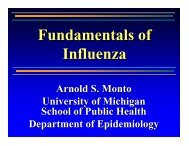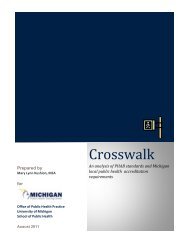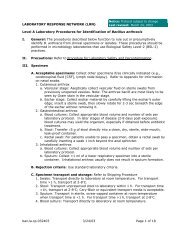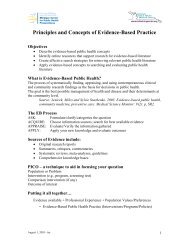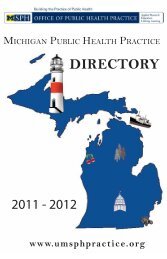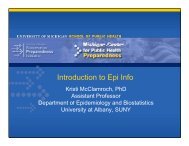Public Health Worker Competencies for Emergency Response
Public Health Worker Competencies for Emergency Response
Public Health Worker Competencies for Emergency Response
You also want an ePaper? Increase the reach of your titles
YUMPU automatically turns print PDFs into web optimized ePapers that Google loves.
<strong>Public</strong> <strong>Health</strong> <strong>Worker</strong> <strong>Competencies</strong> <strong>for</strong><br />
<strong>Emergency</strong> <strong>Response</strong><br />
Kristine Gebbie and Jacqueline Merrill<br />
<strong>Emergency</strong> preparedness is an<br />
expectation of public health<br />
organizations and an expectation of<br />
individual public health practitioners.<br />
Organizational per<strong>for</strong>mance standards<br />
<strong>for</strong> public health agencies have been<br />
developed during the last several<br />
years, providing a foundation <strong>for</strong> the<br />
development of competency<br />
statements to guide individual practice<br />
in public health program areas, like<br />
emergency response. This article<br />
provides results from a project that<br />
developed emergency preparedness<br />
and response competencies <strong>for</strong><br />
individual public health workers.<br />
Documentation of the qualitative<br />
research methods used, which include<br />
competency validation with the<br />
practice community, can be applied to<br />
competency development in other<br />
areas of public health practice.<br />
Key words: competency, emergency<br />
preparedness, emergency<br />
response, practice standards,<br />
public health competencies,<br />
public health practice, work<strong>for</strong>ce<br />
development<br />
Introduction<br />
As increasing attention is paid nationally to the<br />
potential <strong>for</strong> bioterrorism and emerging infectious<br />
diseases, as well as to urgent situations caused by<br />
natural <strong>for</strong>ces such as hurricanes, tornadoes, floods,<br />
or earthquakes, public health organizations have<br />
joined other emergency responders in ef<strong>for</strong>ts to ensure<br />
that response is both timely and appropriate,<br />
whatever the event. From this perspective, emergency<br />
preparedness is both an expectation of public<br />
health organizations and an expectation of individual<br />
members of the public health work<strong>for</strong>ce. The<br />
expected organizational per<strong>for</strong>mance standards in<br />
this area of practice have been drafted and continue<br />
to be refined. 1 The project reported here identified<br />
individual worker competencies necessary <strong>for</strong> an organization<br />
to meet these organizational per<strong>for</strong>mance<br />
standards. The competency statements thus are<br />
complementary to the per<strong>for</strong>mance standards,<br />
though many competencies are not specific to one<br />
organization or program.<br />
<strong>Competencies</strong> may be defined in the following<br />
ways:<br />
• a complex combination of knowledge, skills,<br />
and abilities demonstrated by organization<br />
members that are critical to the effective and efficient<br />
function of the organization 2<br />
• a combination of observable and measurable<br />
Kristine Gebbie, DrPH, RN, is Elizabeth Standish Gill<br />
Associate Professor of Nursing and Director, Center <strong>for</strong><br />
<strong>Health</strong> Policy, Columbia University School of Nursing,<br />
New York, New York.<br />
Jacqueline Merrill, MPH, RN, C, is Project Manager,<br />
Center <strong>for</strong> <strong>Health</strong> Policy, Columbia University School of<br />
Nursing, New York, New York.<br />
J <strong>Public</strong> <strong>Health</strong> Management Practice, 2002, 8(3), 73–81<br />
© 2002 Aspen Publishers, Inc.<br />
This project was supported by CDC/Association of Teachers of<br />
Preventive Medicine Cooperative (ATPM) Agreement No. TS 322<br />
15/16. The authors wish to acknowledge the contributions of Rula<br />
Btoush, RN, MSN, and Meera Gupta, MPH, in preparing this<br />
manuscript.<br />
73
74 JOURNAL OF PUBLIC HEALTH MANAGEMENT AND PRACTICE/MAY 2002<br />
skill, knowledge, per<strong>for</strong>mance behavior, and<br />
personal attributes that contribute to enhanced<br />
employee per<strong>for</strong>mance and organizational success.<br />
3<br />
Competency in <strong>Public</strong> <strong>Health</strong> Practice<br />
Although references to standards of practice in<br />
public health can be found in public health reports<br />
from at least 1923 onwards, 4 the concept of competency-based<br />
practice was adopted by public health<br />
primarily after the publication of the Institute of<br />
Medicine (IOM) 1988 report, The Future of <strong>Public</strong><br />
<strong>Health</strong>, 5 which called <strong>for</strong> reassessment and retooling<br />
of public health education and training.<br />
In 1997, the essential services of public health and<br />
corresponding generic professional competencies<br />
were defined by the <strong>Public</strong> <strong>Health</strong> Functions Project<br />
in its publication, The <strong>Public</strong> <strong>Health</strong> Work<strong>for</strong>ce: An<br />
Agenda <strong>for</strong> the 21st Century. 6 These general competencies<br />
were further developed and recently finalized<br />
after a lengthy public review period by the<br />
Council on Linkages Between Academia and <strong>Public</strong><br />
<strong>Health</strong> Practice. 7<br />
In 1998–99, the <strong>Public</strong> <strong>Health</strong> Practice Program<br />
Office (PHPPO) at the Centers <strong>for</strong> Disease Control<br />
and Prevention (CDC) developed state and local<br />
agency per<strong>for</strong>mance standards corresponding to the<br />
essential services of public health in collaboration<br />
with the public health practice community. 8,9 With<br />
general competencies and agency per<strong>for</strong>mance standards<br />
defined, the next step toward competencybased<br />
public health practice can be directed toward<br />
particular areas of public health practice. As general<br />
public health competencies are further clarified <strong>for</strong><br />
categories of worker and levels of experience, there<br />
will be a continuing need to develop program specific<br />
and profession-specific competencies.<br />
This project demonstrated a practical model <strong>for</strong><br />
the development of individual competencies in any<br />
public health program area using emergency preparedness<br />
as an example. Work is currently under<br />
way in the practice community to refine general<br />
competencies <strong>for</strong> public health workers and to<br />
specify competencies in genomics, in<strong>for</strong>matics, and<br />
public health law. The method described here is<br />
readily adaptable <strong>for</strong> use in these processes. The details<br />
of the research process and methodology used<br />
<strong>for</strong> this project are described fully elsewhere. 10<br />
Methods<br />
The project identified competencies needed to<br />
prepare local public health workers <strong>for</strong> response to<br />
public health emergencies in two stages:<br />
1. identification of competencies most needed by<br />
state and local public health staff in order to be<br />
prepared to respond to any emergency situation,<br />
including bioterrorism, using a panel of<br />
experts in public health and emergency response<br />
2. assessment of the identified competencies with<br />
local and state public health agency representatives,<br />
some with specific recent experience in<br />
bioterrorism response exercises and some with<br />
more general public health experience<br />
Competency identification<br />
The first stage in competency identification used a<br />
Delphi survey method. The Delphi method is a qualitative<br />
research technique that uses a panel of experts<br />
who are surveyed on a subject in successive rounds<br />
of judgment and feedback to develop a consensus of<br />
opinion. It is typically employed in a topic area in<br />
which there is little previously documented knowledge.<br />
11,12<br />
As a first step in the Delphi process, 42 statements<br />
of competency likely to be needed by an individual<br />
public health worker prepared to respond to a range<br />
of emergencies were generated. (<strong>Competencies</strong><br />
needed <strong>for</strong> specific emergencies such as toxicology<br />
or hydrogeology were not included.) These statements<br />
were developed from competencies found in<br />
The <strong>Public</strong> <strong>Health</strong> Work<strong>for</strong>ce: An Agenda <strong>for</strong> the 21st<br />
Century 6 and from state and local public health<br />
agency per<strong>for</strong>mance standards developed by the<br />
CDC PHPPO, 8,9 both of which are grounded in the essential<br />
services of public health.<br />
A Delphi panel of 59 public health and emergency<br />
preparedness experts was recruited from federal,<br />
state, and local professionals identified in consultation<br />
with PHPPO, the Association of State and Territorial<br />
<strong>Health</strong> Officials (ASTHO), the National Association<br />
of County and City <strong>Health</strong> Officials<br />
(NACCHO), and through a literature search of recent<br />
publications on emergency response. Care was taken<br />
that panel composition reflected a range of expertise<br />
by both occupation and level of practice (Table 1).
<strong>Public</strong> <strong>Health</strong> <strong>Worker</strong> <strong>Competencies</strong> 75<br />
Table 1<br />
Delphi Panel Membership by Expertise: Strata of <strong>Public</strong> <strong>Health</strong> Practice*<br />
PH Fed PH State PH Local PH NGO Not PH Total<br />
MD 5 4 6 0 3 18<br />
RN 0 2 4 0 1 7<br />
Admin 5 11 13 0 3 32<br />
E&L 1 7 0 2 0 10<br />
Environmental 0 4 3 0 0 7<br />
ER 6 7 2 1 4 20<br />
Communications 1 0 0 1 0 2<br />
Academic 1 0 0 2 1 4<br />
Bus/Trade 0 0 0 1 1 2<br />
Clerical 0 3 0 0 0 3<br />
14 32 18 7 9<br />
*Columns do not add to 59; individuals have more than one area of expertise.<br />
The Delphi survey asked respondents to rate the<br />
importance of each emergency response competency<br />
statement on a Likert-type scale. For each<br />
statement, this rating scale was applied to the four<br />
major occupational categories of workers: (1) administrators,<br />
(2) professionals, (3) technicians, and (4)<br />
clerical/support staff, using definitions adapted<br />
from the U.S. Office of Personnel Management. 13<br />
The Round I Delphi Survey had a response rate of 98<br />
percent.<br />
A Round II survey was developed that provided<br />
feedback from Round I to the panel. Round II panelists<br />
were asked to indicate by answering yes or no<br />
whether each competency should be selected <strong>for</strong><br />
each category of public health worker. An 85 percent<br />
response rate to Round II was achieved. <strong>Competencies</strong><br />
receiving support from at least 75 percent of the<br />
participants were selected as those necessary <strong>for</strong><br />
each occupational category of public health worker<br />
to respond to an emergency event. As a result, 43 out<br />
of 43 competencies were selected <strong>for</strong> administrative<br />
staff; 43 out of 43 were selected <strong>for</strong> professional staff;<br />
28 out of 43 were selected <strong>for</strong> technical staff; and 7<br />
out of 43 were selected <strong>for</strong> clerical support.<br />
Competency Assessment<br />
The resulting four sets of identified competencies,<br />
one <strong>for</strong> each level of worker, then were explored in a<br />
series of six focus groups with representatives from<br />
federal, state, and local health departments (Table 2).<br />
Focus groups were used <strong>for</strong> this process to allow dis-<br />
Table 2<br />
Focus group participants by agency<br />
Local PH State PH ER agency (not PH) Federal Other<br />
CDC 6 5 10<br />
New Hampshire 23 3 1<br />
Denver 7 2 4 5
76 JOURNAL OF PUBLIC HEALTH MANAGEMENT AND PRACTICE/MAY 2002<br />
cussion among participants, thereby enriching observations<br />
and allowing the research team to probe <strong>for</strong><br />
clarity when comments were brief or unclear.<br />
Two focus groups were conducted at CDC/PHPPO<br />
with a mixture of federal, state, and local personnel.<br />
Four additional groups were held at two sites that<br />
recently participated in major bioterrorism preparedness<br />
drills: the New Hampshire Department of<br />
<strong>Health</strong> and Human Services and the Denver Department<br />
of <strong>Public</strong> <strong>Health</strong> and Environment.<br />
Federal focus group participants were selected by<br />
PHPPO. State and local focus group sites were identified<br />
with the assistance of PHPPO and NACCHO.<br />
Participants in the focus groups were selected with<br />
the assistance of a state or local contact person identified<br />
by NACCHO. At the state and local sites, one<br />
focus group was composed of leaders/administrators<br />
and professional staff and a second focus group was<br />
composed of technical and support staff to ensure<br />
that the full spectrum of the work<strong>for</strong>ce was represented<br />
in a setting that encouraged free exchange of<br />
opinions.<br />
The participants in the focus groups were asked to<br />
consider the following questions:<br />
1. Do staff of federal, state, and local health agencies<br />
generally agree that the identified competency<br />
statements are an appropriate statement<br />
of what staff should be able to do in the area of<br />
emergency preparedness?<br />
2. To what degree can the existing staff of state<br />
and local public health agencies per<strong>for</strong>m the<br />
identified competencies?<br />
3. To the extent that staff cannot now meet the<br />
identified competencies, what should be the<br />
priority <strong>for</strong> staff development of training?<br />
Findings<br />
The focus group feedback confirmed that the competencies<br />
identified through the Delphi process were<br />
an accurate reflection of what was needed in the<br />
practice setting <strong>for</strong> successful response to emergency<br />
situations. The participants suggested three major<br />
changes:<br />
1. Employ straight<strong>for</strong>ward language and <strong>for</strong>mat<br />
competencies that apply to all workers into a<br />
brief and user-friendly core set that will not<br />
overwhelm practitioners.<br />
2. Condense the competencies that apply specifically<br />
to each of the four levels of workers into<br />
shorter subsets that can be used more readily,<br />
given that fewer workers need these additional<br />
competencies.<br />
3. Increase emphasis in the public health leader/<br />
administrator set on competencies in communicating,<br />
coordinating, and planning <strong>for</strong> emergency<br />
response, both within and without the<br />
agency.<br />
Based on this feedback, a core set of nine competencies<br />
applicable to all public health workers was<br />
extracted from the four competency sets identified<br />
by the Delphi panelists. <strong>Competencies</strong> beyond this<br />
basic set were merged and consolidated <strong>for</strong> each occupational<br />
category of public health worker, resulting<br />
in seven competencies in addition to the core set<br />
<strong>for</strong> the administrator/leader, three competencies in<br />
addition to the core set <strong>for</strong> the professional, and two<br />
competencies in addition to the core set <strong>for</strong> technical<br />
and support staff. An introduction was crafted to<br />
guide usage. The introduction reflects focus group<br />
feedback on the importance of each public health<br />
agency customizing the competencies to represent<br />
the unique role and responsibility that agency has <strong>for</strong><br />
emergency preparedness and response within its jurisdiction.<br />
Also based on focus group feedback, short<br />
clarifying statements were added to some competencies.<br />
The resulting Core <strong>Public</strong> <strong>Health</strong> <strong>Worker</strong> <strong>Competencies</strong><br />
<strong>for</strong> <strong>Emergency</strong> Preparedness and <strong>Response</strong><br />
are found in the box titled, “<strong>Emergency</strong> Preparedness<br />
<strong>Competencies</strong> <strong>for</strong> All <strong>Public</strong> <strong>Health</strong> <strong>Worker</strong>s.”<br />
Abbreviating the long list of competencies <strong>for</strong> use<br />
in the field was an essential step toward creating a<br />
product readily useable by the overall work<strong>for</strong>ce.<br />
However, the process of condensing the material left<br />
out details found in the 43 competencies originally<br />
identified by the Delphi panel. To recapture this substantial<br />
detail, which would be needed to develop<br />
preparedness programs at the agency level, the original<br />
Delphi-identified competencies were mapped<br />
back into the core sets to create annotated competencies<br />
<strong>for</strong> each level of worker. That is, the content of<br />
each of the 43 original competency statements was<br />
listed under its corresponding core competency. The<br />
annotated competencies provide detailed statements<br />
to support the use of the competencies by public<br />
health educators and planners to develop educa-
<strong>Public</strong> <strong>Health</strong> <strong>Worker</strong> <strong>Competencies</strong> 77<br />
Abbreviating the long list of<br />
competencies <strong>for</strong> use in the field was<br />
an essential step toward creating a<br />
product readily useable by the overall<br />
work<strong>for</strong>ce.<br />
tional programs on emergency preparedness and response<br />
<strong>for</strong> public health workers.<br />
The finalized sets of core competencies and annotated<br />
competencies were validated via review by<br />
public health workers in a large urban health department.<br />
These workers included both administrative<br />
and professional leadership and staff. The core competencies<br />
were perceived as generally valid by these<br />
groups. A sample definition of the emergency response<br />
role of a typical health department was recommended<br />
and subsequently added.<br />
The finalized sets of competencies also were<br />
mailed to all original participants of the Delphi<br />
panel. Although invited, no further comments were<br />
received from panel members. The competencies<br />
currently are being used by the Mailman School of<br />
<strong>Public</strong> <strong>Health</strong> Center <strong>for</strong> <strong>Public</strong> <strong>Health</strong> Preparedness<br />
to develop an emergency preparedness program <strong>for</strong><br />
approximately 5,000 workers employed at the New<br />
York City Department of <strong>Health</strong>.<br />
Work<strong>for</strong>ce Competency<br />
All focus groups indicated that public health staff<br />
members at all levels at best are prepared unevenly<br />
to respond to emergencies. Key findings include:<br />
• <strong>Public</strong> health work generally is considered to be<br />
regular hours/weekday work in contrast to the<br />
schedules of hospitals and other care facilities.<br />
Most workers are not prepared <strong>for</strong> round-theclock<br />
response if it is not already routinely part<br />
of their job. Local union contracts need attention<br />
during response planning, as these contracts often<br />
do not address response-related labor issues<br />
specifically.<br />
• Understanding both the public health agency’s<br />
mission in emergency response and the individual’s<br />
own role in response were considered<br />
key <strong>for</strong> competent response. This understanding<br />
was considered to be underdeveloped<br />
among public health workers.<br />
• <strong>Public</strong> health leadership’s role in establishing<br />
the public health agency as a collaborator with<br />
other emergency responders was considered underdeveloped.<br />
Likewise, more is needed from<br />
leaders in establishing internal agency awareness<br />
and preparedness <strong>for</strong> emergency response.<br />
• <strong>Public</strong> health workers normally are not exposed<br />
to Incident Command System (ICS) protocols<br />
and terminology used by traditional responders<br />
like fire and police. This was felt to place public<br />
health workers at a disadvantage organizationally<br />
when called upon to partner with these<br />
agencies.<br />
• <strong>Emergency</strong> response plans were perceived as<br />
not in place, not well developed, not available to<br />
all levels of staff, or not regularly reviewed and<br />
updated. The need <strong>for</strong> establishing a routine<br />
protocol <strong>for</strong> updating emergency contact in<strong>for</strong>mation<br />
was stressed. Participants in all focus<br />
groups made the point that important practical<br />
knowledge regarding an agency’s emergency response<br />
protocols might reside only in the head<br />
of an experienced administrator or other<br />
longstanding staff member.<br />
• <strong>Public</strong> health workers’ capability to operate the<br />
communication equipment that might be required<br />
in emergency response, from fundamental<br />
telephone call transfers to broadcast faxing,<br />
was considered unevenly developed.<br />
Discussion<br />
This project has developed a valid, useful, and acceptable<br />
set of competencies in the emerging area of<br />
public health emergency preparedness through a<br />
process of:<br />
• drafting potential competencies using literature<br />
and experts<br />
• validating and expanding draft competencies<br />
using a Delphi panel of experts<br />
• confirming and clarifying the identified competencies<br />
with a range of public health practitioners<br />
by means of focus groups<br />
Other competency identification projects have<br />
used or are using methods similar to those used by
78 JOURNAL OF PUBLIC HEALTH MANAGEMENT AND PRACTICE/MAY 2002<br />
this project. The Council on Linkages Between<br />
Academia and <strong>Public</strong> <strong>Health</strong> Practice has used a process<br />
of e-mail, focus groups, conference presentations,<br />
and Web feedback to develop a consensus set<br />
of core competencies <strong>for</strong> general public health practice.<br />
7 <strong>Emergency</strong> preparedness and response competencies<br />
complement these general public health<br />
competencies by providing the detail required <strong>for</strong> a<br />
specific area of public health practice.<br />
The process of developing specific program or<br />
practice-specific competencies will continue. For example,<br />
genomic competencies 14,15 and competencies<br />
in public health law 16 are being developed through<br />
processes that resemble this one. In both cases, small<br />
groups of experts have proposed competency sets<br />
and a wider range of experienced practitioners are<br />
providing feedback. In all cases of competency development<br />
in emerging areas, final validation must<br />
wait until field implementation.<br />
Key to the project’s success was regular consultation<br />
with experts in emergency response and with<br />
public health practitioners. Development of draft<br />
statements <strong>for</strong> inclusion in the first Delphi round ensured<br />
that competency statements were consistent<br />
with the full range of essential public health services.<br />
The Delphi process allowed a wide range of expertise<br />
and opinion to be included at relatively low cost. Finally,<br />
the use of focus groups in the field ensured<br />
that the final product was both consistent with the<br />
expert Delphi panel’s findings and presented in a<br />
<strong>for</strong>m readily understood by and useful to busy public<br />
health practitioners.<br />
Follow through on this project includes development<br />
of competency-based emergency preparedness<br />
curriculum <strong>for</strong> all levels of workers and all types of<br />
public health agencies. Education about specific possible<br />
emergencies, such as bioterrorism, is offered in<br />
the response community and continues to be developed<br />
<strong>for</strong> use by public health. Some of this work is<br />
being undertaken in seven academic Centers <strong>for</strong> <strong>Public</strong><br />
<strong>Health</strong> Preparedness recently funded by CDC/<br />
PHPPO. At the agency level, adjustment of job descriptions<br />
and agency orientation to include emergency<br />
preparedness will require attention. <strong>Public</strong><br />
health will continue to respond to emergencies of all<br />
types. These competencies in emergency preparedness<br />
can be used to ensure that each individual<br />
worker is ready to participate when needed.<br />
REFERENCES<br />
1. Centers <strong>for</strong> Disease Control and Prevention. Draft: <strong>Emergency</strong><br />
preparedness model standards. Atlanta: U.S. Department of<br />
<strong>Health</strong> and Human Services, 2000.<br />
2. Nelson, J.C., Essien, J.D.K., Latoff, J.S., and Wiesner, P.J. Collaborative<br />
competence in the public health agency: Defining<br />
per<strong>for</strong>mance at the organizational and individual employee<br />
levels. Paper presented at the PREVENTION 97 Conference:<br />
Research Linkages between Academia and Practice, Atlanta,<br />
Georgia, 1997.<br />
3. American Compensation Association. “The role of competencies<br />
in an integrated HR strategy.” American Compensation<br />
Association Journal 5, 2 (1996): 6–21.<br />
4. U.S. Treasury Department/<strong>Public</strong> <strong>Health</strong> Service. “Municipal<br />
health department practice <strong>for</strong> the year 1923 based upon surveys<br />
of the 100 largest cities in the United States.” <strong>Public</strong><br />
<strong>Health</strong> Bulletin. No. 164 (1926).<br />
5. Institute of Medicine, Committee <strong>for</strong> the Study of the Future of<br />
<strong>Public</strong> <strong>Health</strong>. The future of public health. Washington, DC:<br />
National Academy Press, 1988.<br />
6. U.S. Department of <strong>Health</strong> and Human Services. The public<br />
health work<strong>for</strong>ce: An agenda <strong>for</strong> the 21st century. Washington,<br />
DC: Government Printing Office, 1997.<br />
7. Council on Linkages Between Academia and <strong>Public</strong> <strong>Health</strong><br />
Practice. Core competencies <strong>for</strong> public health professionals<br />
(2001) www.trainingfinder.org/competencies.<br />
8. Centers <strong>for</strong> Disease Control and Prevention. Draft: National<br />
<strong>Public</strong> <strong>Health</strong> Per<strong>for</strong>mance Standards Program State <strong>Public</strong><br />
<strong>Health</strong> System Per<strong>for</strong>mance Assessment Instrument-Version:<br />
State Tool September 1999. <strong>Public</strong> <strong>Health</strong> Practice Program<br />
Office (1999) www.phppo.cdc.gov/dphs/nphpsp/state_<br />
instrument.asp.<br />
9. Centers <strong>for</strong> Disease Control and Prevention. Local public<br />
health per<strong>for</strong>mance assessment: Pilot instrument, March<br />
1999 (1999) www.phppo.cdc.gov/dphs/nphpsp/local_<br />
instrument.asp.<br />
10. Gebbie, K., Merrill, J., Hwang, I., Gupta, M., Btoush, R., and<br />
Wagner, M. Identifying individual competency in emerging<br />
areas of practice: An applied qualitative research approach.<br />
Qualitative <strong>Health</strong> Research. In press.<br />
11. Adler, M., and Ziglio, E. Gazing into the oracle: The Delphi<br />
method and its application to social policy and public health.<br />
Bristol, PA: Jessica Kingsley Publishers, 1996.<br />
12. Linstone, H., and Turoff, M. The Delphi method: Techniques<br />
and applications. Reading, MA: Addison-Wesley Publishing<br />
Company, 1975.<br />
13. U.S. Office of Personnel Management. Federal civilian work<strong>for</strong>ce<br />
statistics: Occupations of federal white-collar and bluecollar<br />
workers, As of September 30, 1997 (1999) www.opm.<br />
gov/feddata.<br />
14. CDC Office of Genetics and Prevention. <strong>Competencies</strong> <strong>for</strong><br />
the public health work<strong>for</strong>ce: Integrating genetics into public<br />
health practice (2001) http://www.cdc.gov/genetics/activi-
<strong>Public</strong> <strong>Health</strong> <strong>Worker</strong> <strong>Competencies</strong> 79<br />
ties/public.htm.<br />
15. National Coalition <strong>for</strong> <strong>Health</strong> Professional Education in Genetics.<br />
Core competencies in genetics essential <strong>for</strong> all health<br />
care professionals (2000) http://www.nchpeg.org/.<br />
16. Center <strong>for</strong> Law and the <strong>Public</strong>’s <strong>Health</strong>. Core legal competencies<br />
<strong>for</strong> public health practitioners (2001) http://<br />
www.publichealthlaw.net/Training/TrainingPDFs/<br />
PHL<strong>Competencies</strong>.
80 JOURNAL OF PUBLIC HEALTH MANAGEMENT AND PRACTICE/MAY 2002<br />
<strong>Emergency</strong> Preparedness <strong>Competencies</strong> <strong>for</strong> All <strong>Public</strong> <strong>Health</strong> <strong>Worker</strong>s<br />
Introduction: Using Core <strong>Competencies</strong><br />
I. Some core competencies in emergency preparedness are applicable to every public health worker; others are specific to<br />
those in administrative, professional, and technical or support positions. Core competencies can be used in:<br />
1. Updating/revising job descriptions:<br />
Does each job description in public health include reference to emergency responsibilities and tasks?<br />
2. As an outline <strong>for</strong> new employee orientation and employee training:<br />
The specifics of the agency plan, the organizational chart, and the employees place in the jurisdictional plan are<br />
needed to make these competencies meaningful. The size of the jurisdiction and agency will dictate how general<br />
or specific an individual’s job may be.<br />
3. Self-assessment by public health employees:<br />
Am I able to …<br />
Training <strong>for</strong> and measurement of these core competencies in public health emergency preparedness requires tailoring<br />
them to the structure and function of the individual public health agency.<br />
II.<br />
The general role of public health in emergencies is an extension of the general mission of public health:<br />
to promote physical and mental health and prevent disease, injury, and disability (from <strong>Public</strong> <strong>Health</strong> in America).<br />
Depending upon the type of emergency and the decisions about emergency response made within a given jurisdiction,<br />
the public health agency may be in the lead position, in a collaborative role, or in a secondary/supportive role. In order<br />
<strong>for</strong> the agency to fulfill its role, the public health agency staff must be competent to carry out their responsibilities.<br />
Core competencies such as these cannot replace the specific description of any job in public health, nor the specific<br />
emergency plan <strong>for</strong> any public health organization. They can ensure, if mastered, that the individual public health<br />
worker will be able to per<strong>for</strong>m his/her job and his/her functions in emergency circumstances.<br />
<strong>Competencies</strong> <strong>for</strong> All <strong>Public</strong> <strong>Health</strong> <strong>Worker</strong>s<br />
In order <strong>for</strong> the public health system to meet per<strong>for</strong>mance standards in emergency preparedness all public health workers<br />
must be competent to:<br />
1. Describe the public health role in emergency response in a range of emergencies that might arise (e.g., “This department<br />
provides surveillance, investigation, and public in<strong>for</strong>mation in disease outbreaks and collaborates with other<br />
agencies in biological, environmental, and weather emergencies.”)<br />
2. Describe the chain of command in emergency response<br />
3. Identify and locate the agency emergency response plan (or the pertinent portion of the plan)<br />
4. Describe his/her functional role(s) in emergency response and demonstrate his/her role(s) in regular drills<br />
5. Demonstrate correct use of all communication equipment used <strong>for</strong> emergency communication (phone, fax, radio,<br />
etc.)<br />
6. Describe communication role(s) in emergency response<br />
• within agency<br />
• media<br />
• general public<br />
• personal (family, neighbors)<br />
7. Identify limits to own knowledge/skill/authority and identify key system resources <strong>for</strong> referring matters that exceed<br />
these limits<br />
8. Apply creative problem solving and flexible thinking to unusual challenges within his/her functional responsibilities<br />
and evaluate effectiveness of all actions taken<br />
9. Recognize deviations from the norm that might indicate an emergency and describe appropriate action (e.g., communicate<br />
clearly within the chain of command)
<strong>Public</strong> <strong>Health</strong> <strong>Worker</strong> <strong>Competencies</strong> 81<br />
Additional <strong>Competencies</strong> <strong>for</strong> <strong>Public</strong> <strong>Health</strong> Leaders/Administrators 1<br />
The following competencies will be combined with those of the Professional (see below) <strong>for</strong> leader/administrators who also<br />
have medical, nursing or other professional duties.<br />
1. Describe the chain of command and management system (“incident command system” or similar protocol) <strong>for</strong> emergency<br />
response in the jurisdiction<br />
2. Communicate public health in<strong>for</strong>mation/roles/capacities/legal authority accurately to all emergency response partners,<br />
such as other public health agencies, other health agencies, and other government agencies during planning,<br />
drills, and actual emergencies (e.g., includes contributing to effective community-wide response through leadership,<br />
team building, negotiation, and conflict resolution)<br />
3. Maintain regular communication with emergency response partners (includes maintaining a current directory of partners<br />
and identifying appropriate methods <strong>for</strong> contact in emergencies)<br />
4. Ensure that the agency (or agency unit) has a written, updated plan <strong>for</strong> major categories of emergencies that respects<br />
the culture of the community<br />
5. Ensure that the agency (or agency unit) regularly practices all parts of emergency response<br />
6. Evaluate every emergency response drill/emergency response to identify needed internal/external improvements<br />
7. Ensure that knowledge/skill gaps identified through emergency response planning, drills and evaluation are filled<br />
Additional <strong>Competencies</strong> <strong>for</strong> <strong>Public</strong> <strong>Health</strong> Professionals 2<br />
The following competencies will be combined with those of the Leader/Administrator (see above) <strong>for</strong> professionals who also<br />
have management duties.<br />
1. Demonstrate readiness to apply professional skills to a range of emergency situations during regular drills (e.g., access,<br />
use, and interpretation of surveillance data; access to and use of lab resources; access to and use of science-based<br />
investigation protocols and risk assessment; selection and use of appropriate personal protective equipment)<br />
2. Maintain regular communication with partner professionals in other agencies involved in emergency response (e.g.,<br />
includes contributing to effective community wide response through leadership, team building, negotiation and conflict<br />
resolution)<br />
3. Participate in continuing education to maintain up-to-date knowledge in areas relevant to emergency response (e.g.,<br />
emerging infectious diseases, hazardous materials, diagnostic tests, etc.)<br />
Additional <strong>Competencies</strong> <strong>for</strong> <strong>Public</strong> <strong>Health</strong> Technical 3 & Support 4 Staff<br />
1. Demonstrate the use of equipment (including personal protective equipment) and skills associated with his/her functional<br />
role in emergency response during regular drills<br />
2. Describe at least one resource <strong>for</strong> back up/support in key areas of responsibility<br />
1<br />
Leader/administrative occupations involve the exercise of analytical ability, judgment, discretion, personal responsibility, and the application<br />
of a substantial body of knowledge of principles, concepts, and practices applicable to one or more fields of administration or management.<br />
NB: <strong>Public</strong> health leaders/administrators also may be public health professionals serving in a leadership/administrative capacity.<br />
2<br />
Professional occupations require knowledge in a field of science or learning characteristically acquired through education or training<br />
equivalent to a bachelor’s or higher degree with major study in or pertinent to the specialized field. The work of a professional occupation<br />
requires the exercise of discretion, judgment, and personal responsibility <strong>for</strong> the application of an organized body of knowledge that is<br />
studied constantly to make new discoveries and interpretations and to improve the data, materials, and methods.<br />
3<br />
Technical occupations involve non-routine work and typically are associated with and supportive of a professional or administrative field.<br />
Such occupations involve extensive practical knowledge gained through on-the-job experience or training less than that represented by<br />
college graduation and involve substantial elements of the work of the professional or administrative field but requires less than full competence<br />
in the field involved.<br />
4<br />
Clerical/support occupations involve structured work in support of office, business, or fiscal operations; duties are per<strong>for</strong>med according to<br />
established policies or techniques and require training, experience, or working knowledge related to the tasks to be per<strong>for</strong>med.<br />
Adapted from the U.S. Office of Personnel Management.



